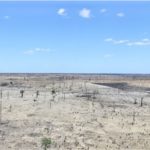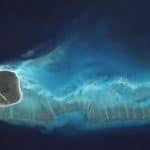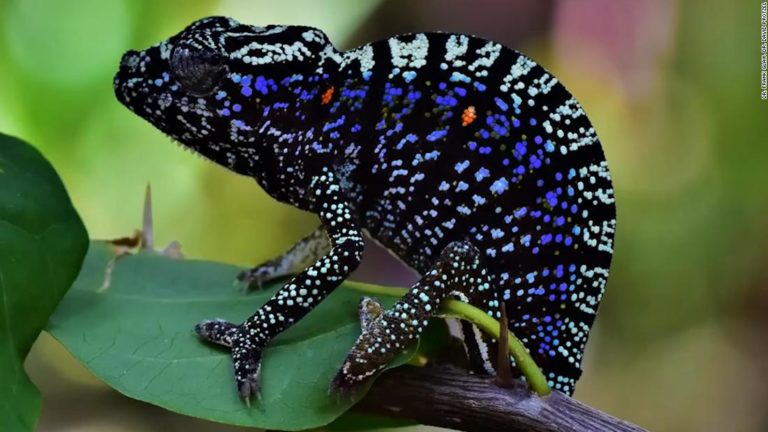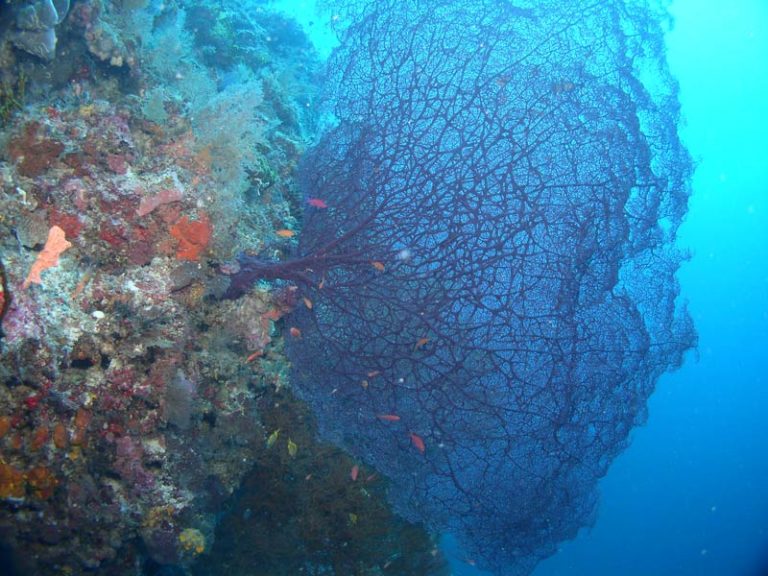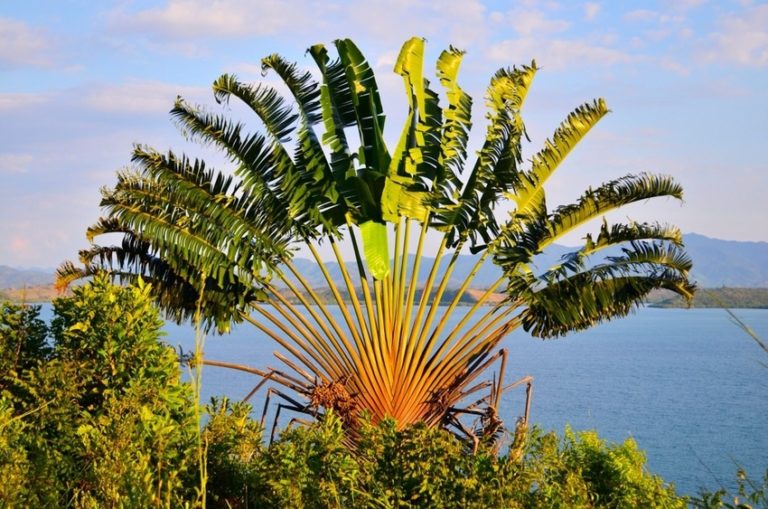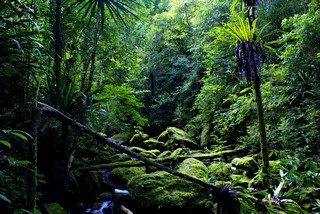Chameleons in Madagascar
Madagascar is famous for its biodiversity. This nature rises through its beauty, its colors 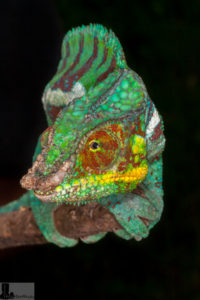
In Madagascar we find more than half of the 150 species of chameleons existing in the world, and a large part of the species is even endemic to the island. They can be divided into three main chameleon species: the greater Furcifer, known for its horns Calumma and Brookesia, which belongs to the smaller chameleons.
Description of the chameleons of Madagascar
As a scientific name, the chameleon is called "Chamaeleonidae", a species of the dinosaur family, more precisely a descendant of a suborder of reptiles. It is a four-legged tree that feeds exclusively on insects.
The morphology of a chameleon varies by species, in Madagascar ranging in size from 25 millimeters (the smallest chameleons in the world!) to 50 centimeters (including tail) for the largest.
The head
Like a benevolent avatar, the chameleon's head varies according to its size, but especially according to its type. Larger ones, like the Furcifer genus, have a certain flat bump that forms a ridge or helmet on the head. Most of these creatures all have this helmet, but the smaller ones do not.
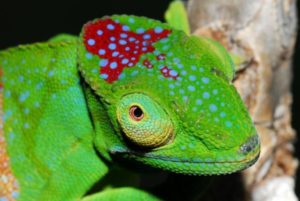
Diet and insect hunting
Remember that this animal feeds exclusively on insects such as flies and butterflies, but the favorite food of chameleons of the island are grasshoppers and crickets. For this purpose, the chameleon has a rather long tongue, which is stored in the head with the hyoid bone.
Equipped with great muscular strength, the chameleon can push its tongue back and forth at will: It is a real natural harpoon, his little hunting tool. Moreover, he can reach a speed of 20km/h when he takes off! The wall of his tongue is filled with viscous mucus, which serves as a net or, more precisely, as a kind of glue to immobilize his prey. Then it is brought back into the mouth by pulling back its tongue. Bon appetit!
The skin of the chameleon
The skin of the Madagascar chameleons is pigmented and has different layers of skin that allow it to change color depending on the environment or an attitude it wants to convey. Special cells, 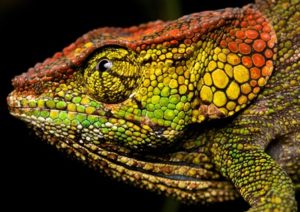
Recently, Swiss researchers at the University of Geneva conducted experiments on a panther chameleon native to the island. They claim that the elements that control color change in Chamaeleonidae are "nanocrystals." Tiny crystals found in a superficial layer of skin cells called "iridophores."
"These nanocrystals, arranged in multiple layers, respond to the wavelengths of light by reflecting bluish hues," the researchers said. However, many reptiles possess these crystals, but the only one capable of arranging its own crystals at will is the chameleon.
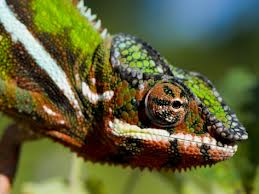
Researchers have so far 200 species of chameleons identified around the world. 150 species are recorded here on the large island of Madagascar, including 59 endemic species.
Categorization of chameleons endemic to Madagascar.
The chameleons of Madagascar live only on the island and are divided into three genera. Namely: Furcifer, Brookesia and Calumma, which have 84 subspecies that inhabit different habitats and regions of the Big Island.
Brookesia chameleons
Brookesia are also Earth Chameleons called, it is an endemic genus of Stub-tailed chameleons which is native only to Madagascar.
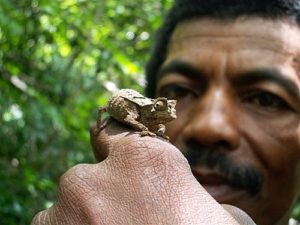
Brookesia Micro for example, a tiny chameleon of 25 millimeters in length, belongs to this genus. It is considered the smallest reptile on earth. Unlike other species, Brookesia chameleons lack a prehensile tail. They are mostly terrestrial chameleons whose tails are not used much, unlike the other genera.
Furcifer chameleons
With 50 cm (including tail) this chameleon genus gathers the largest species of Madagascar. The majority of the genus lives in trees or clearings.
Chameleon Furcifer feeds on insects and small reptiles. Among this species we find the most beautiful specimens, namely: the Oustalet chameleon or Furcifer oustaleti, the Panther chameleon or Furcifer pardalis and the Furcifer minor-Art.
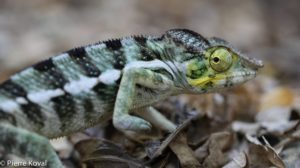
- Furcifer bifidus Group consists of six species that live in the rainforest
- Furcifer pardalis Group also consists of six species, they are native to the northern part of Madagascar and live in the lowlands.
- Furcifer Verrucosus Group consists of three species and the best known of them is F.Oustaletti which is distributed on the highlands and in the south.
- Furcifer Rhinoceratus Group consists of three species and are medium-sized chameleons.
- Furcifer Lateralis Group consists of two types.
This chameleon genus currently includes about 20 species.
Calumma chameleons
As with Furcicifer chameleons, these reptiles have very colorful coloration with rapid and remarkable color changes.

This group consists of almost 40 species and lives exclusively on shrubs and trees in different biotopes up to almost 2000m altitude.
The chameleons in the Malagasy culture
In Malagasy culture, the chameleon occupies an important place. In some regions it is part of many tales and legends and sometimes even a source of superstition.
Today, chameleons have an integral place in the country's biodiversity and culture. However, the disturbing increase in deforestation and bushfires threatens to
Mythology and dealing with the afterlife
In most ethnic groups of Africa and the Caribbean islands, various myths are associated with the presence of chameleons, which are considered a kind of messenger between man and deities. In the past, chameleons were the carriers of a certain message sent by the highest beings.
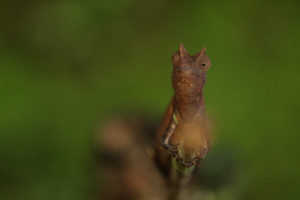
The chameleon came later and confirmed that "people die but are born again afterwards". But people no longer believed him and did not accept his message that death is only temporary. In this way, man became mortal.
This myth is quite widespread on the African continent and also exists in Malagasy culture, especially among the Betsimisaraka ethnic group. This species, considered as mediators between man and nature or even between man and supreme beings, spreads a certain "fear" or "superstition" about the Malagasy.
Literature on the subject:
Amphibians and Reptiles of Madagascar. Vences & Glaw, Cologne 2007, ISBN 978-3-929449-03-7.




